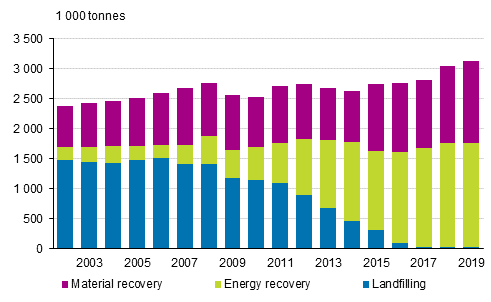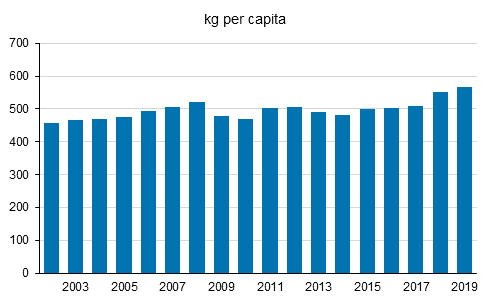Published: 9 December 2020
Amount of municipal waste grew slightly in 2019 – most of waste was still recovered as energy
Over three million tonnes of municipal waste was generated in 2019. Compared with the previous year, the total amount of waste increased by 80,000 tonnes, or by just under three per cent. No great changes took place in the mutual shares of treatment modes of waste. The amount of waste corresponded to around 565 kg calculated per inhabitant.
A total of 3,122,705 tonnes of municipal waste were generated in 2019. Compared with the previous year, the growth amounted to around 80,000 tonnes, or just under three per cent. The growth in the amount of waste was more moderate than in the previous year. In addition to waste generated in housing, comparable waste from trade, manufacturing and services is regarded as municipal waste.
Energy recovery was still the most significant treatment method of municipal waste
No great changes took place in the mutual shares of treatment methods of waste. Since 2012 energy recovery of waste has been the most significant treatment mode of municipal waste – in 2019 its share fell slightly, to 56 per cent. Energy recovery of municipal waste is based on combined production of electricity and heat, and the heat is often utilized in district heating networks.
Municipal waste by treatment method in 2002 to 2019

The share of material recovery of waste grew slightly, being 43 per cent. Due to the landfill prohibition of organic waste that came into force in 2016, municipal waste is no longer deposited at landfills. In 2019, the share of landfill disposal was under one per cent.
Especially biowaste and plastic was recycled more than before
Over 1.5 million tonnes of mixed waste were generated in municipalities: the amount grew by just under five per cent from the previous year. Nearly all mixed waste ends up in energy recovery.
The total amount of waste components collected separately as material remained on level with the previous year, at 1.4 million tonnes. Paper and paperboard and biowaste have long been the biggest separately collected material items. The volume of separately collected paper and board waste decreased by just under ten per cent.
Nine per cent more biowaste was collected separately than in the previous year, and the growth explains most of the growth in material recovery. Most of biowaste was composted and decomposed; in all, the amount composted and decomposed grew by over 13 per cent from the previous year. Decomposition produces biogas, in addition to which the decomposition residue and compost soil can be utilised in soil improvement or landscape development.
Among other separately collected waste, the growth was biggest in the volume of plastic waste, which grew by over ten per cent. This was particularly visible in increased material recovery of plastic. More metal waste was also recycled than before.
No major changes took place in the total amount of wood waste, but the amount of wood waste recovered as material grew by over 40 per cent as burning wood for energy decreased.
Amount of municipal waste grew to 565 kg per capita
The amount of waste also grew relative to Finland's population. At the beginning of the 2010s, the amount of waste settled at around 500 kg per capita. In 2019, the amount of municipal waste was 565 kg per person, growing by 15 kg from the year before.
Municipal waste generated per capita in 2002 to 2019

Source: Waste statistics 2019, Municipal waste, Statistics Finland
Inquiries: Heidi Pirtonen 029 551 3093, Juha Espo 029 551 3463, ymparistotilinpito@stat.fi
Head of Department in charge: Mari Ylä-Jarkko
Publication in pdf-format (206.0 kB)
- Tables
-
Tables in databases
Pick the data you need into tables, view the data as graphs, or download the data for your use.
Appendix tables
- Appendix table 1. Municipal waste 2019, tonnes (9.12.2020)
Updated 9.12.2020
Official Statistics of Finland (OSF):
Waste statistics [e-publication].
ISSN=2323-5314. Municipal waste 2019. Helsinki: Statistics Finland [referred: 27.12.2025].
Access method: http://stat.fi/til/jate/2019/13/jate_2019_13_2020-12-09_tie_001_en.html

